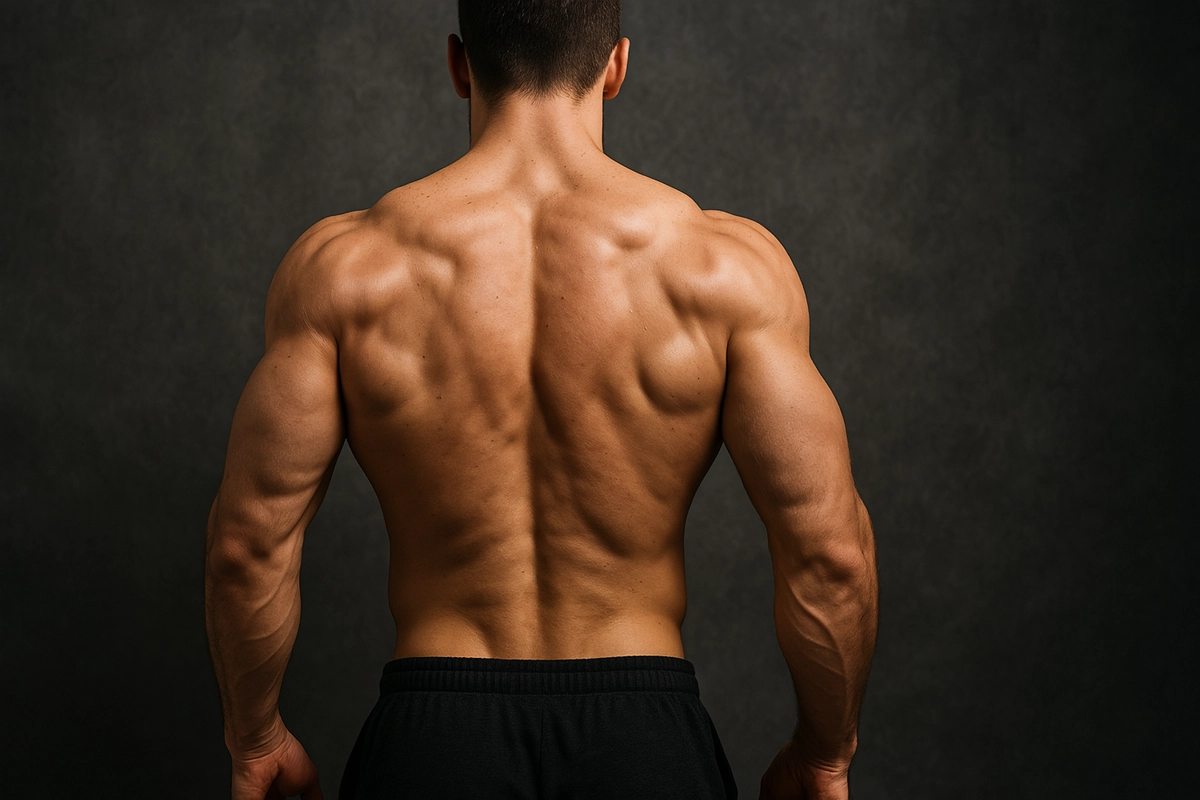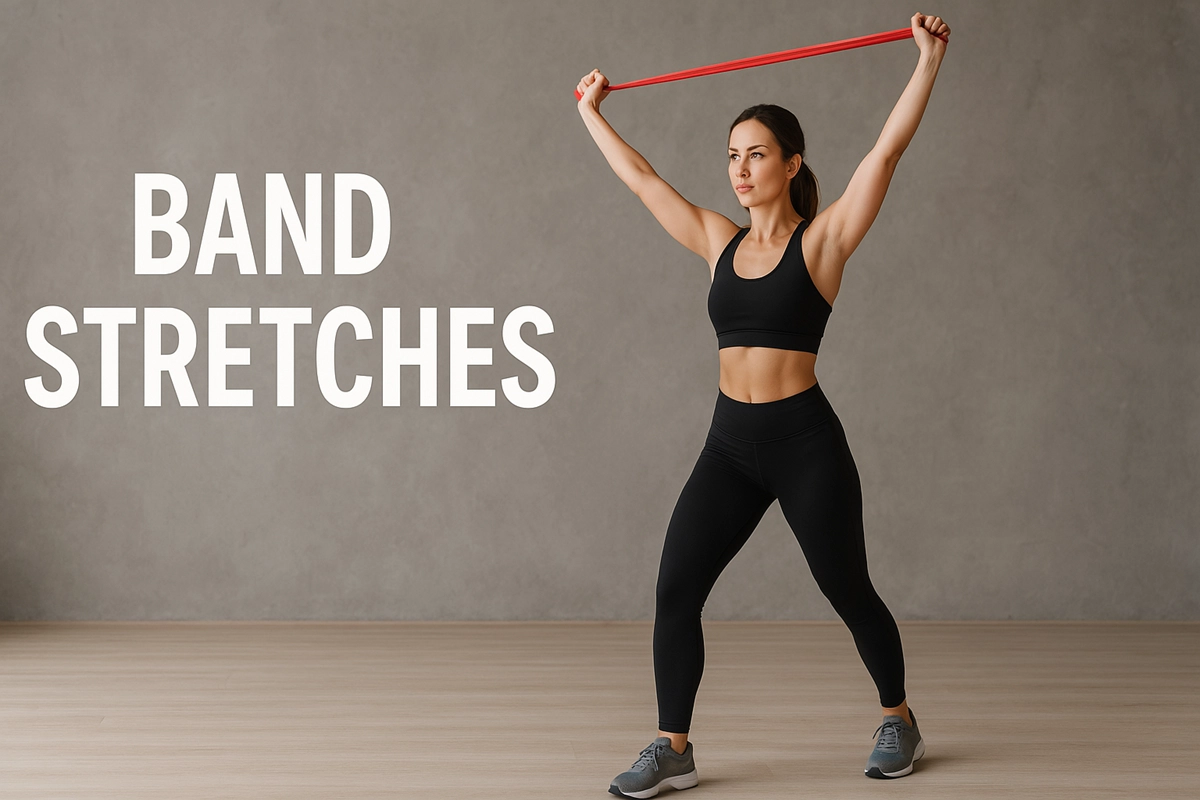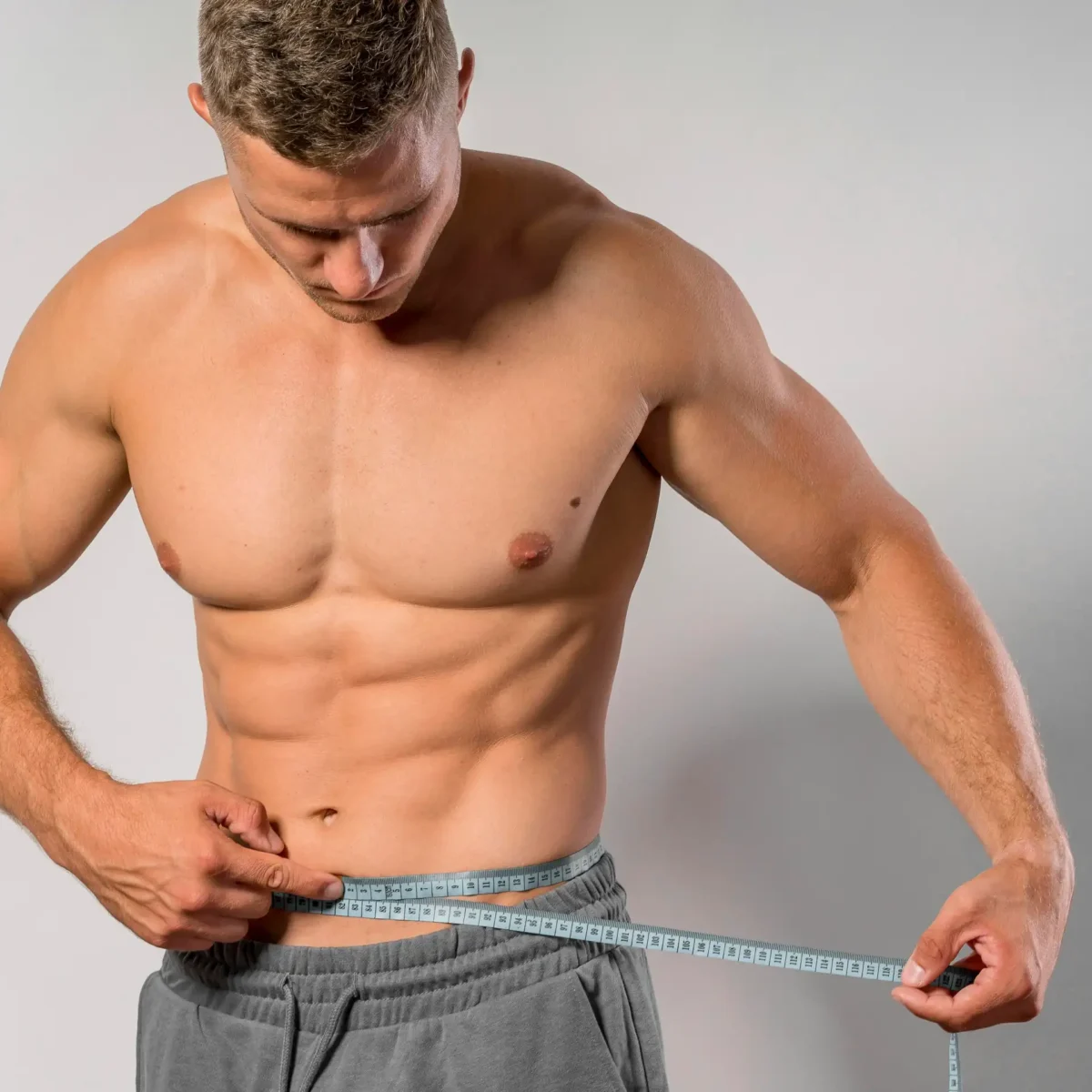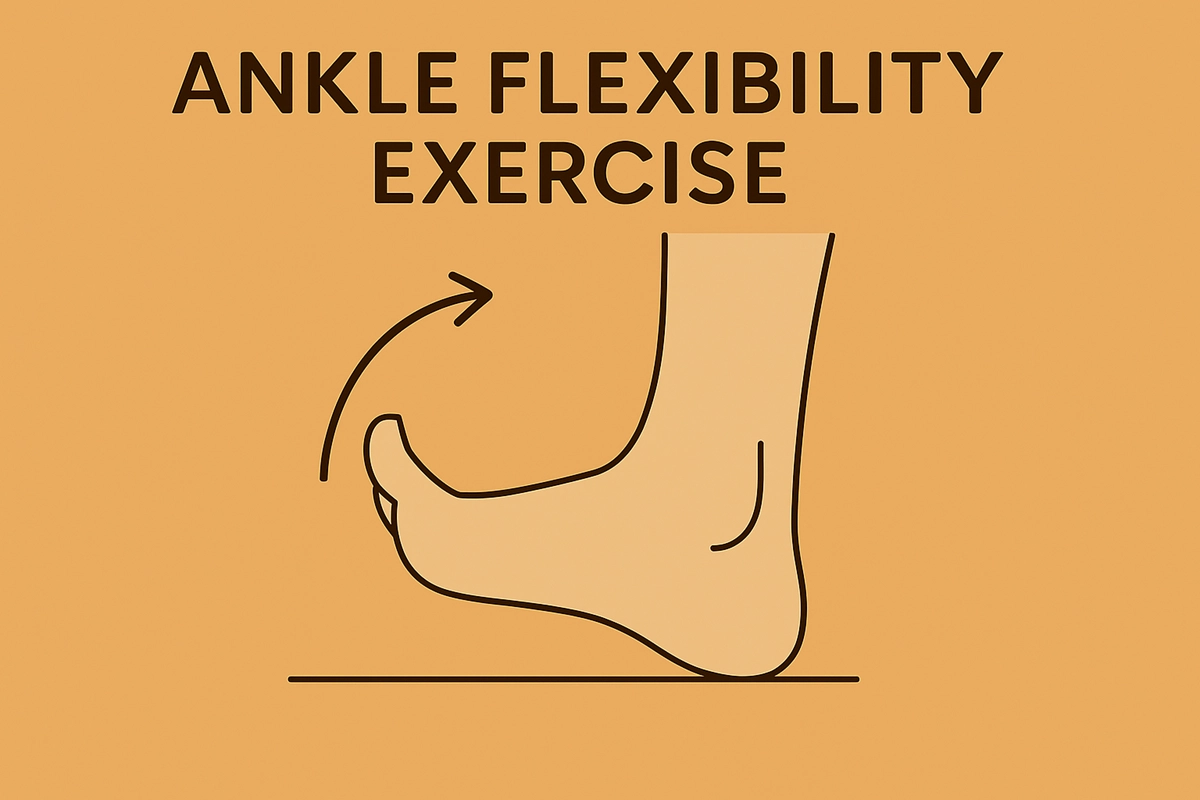Your back muscles need strength for daily tasks, athletic performance, and long-term health.
You’ll find that proper back training isn’t just about pulling weights – it’s about mastering fundamental movement patterns that Arnold himself emphasized throughout his career.
Whether you’re a beginner looking to improve posture or an experienced lifter aiming for that coveted V-taper, these 15 exercises will transform your back training approach. Let’s explore why these movements have endured over time.
The warmup
Before diving into your intense back workout, you’ll need to prepare your body with an effective warm-up routine. Start with 5-10 minutes of moderate cardio activities, such as jogging, jumping jacks, or using a rowing machine, to increase blood flow and activate your core muscles. This initial phase helps prevent injury and optimizes your upcoming workout performance.
Once you’ve completed the cardio portion, shift into a 5-minute dynamic stretching sequence.
These controlled movements will specifically target your back muscles and surrounding areas, ensuring proper muscle strength development. Focus on exercises that gradually increase your range of motion while keeping your muscles engaged.
As Arnold always said, “The mind is the limit,” but a proper warmup is what sets the foundation for a successful training session.
1. Resistance Band Pull-Apart
Three key reasons make the resistance band pull-apart an essential starting exercise for your back workout. First, it effectively targets your upper traps, rhomboids, and rear deltoids through controlled scapular retraction.
Second, it’s perfect for building shoulder stability by strengthening your rotator cuff muscles. Third, it’s simple to perform yet delivers powerful results.
To perform this exercise, stand with your arms extended and hold a resistance band in front of you parallel to the floor. Pull the band apart by moving your arms outward while keeping them straight.
Focus on squeezing your shoulder blades together, maintaining a neutral spine throughout the movement. You’ll want to complete 1-3 sets of 8-12 reps with a band that provides sufficient resistance to maintain proper form.
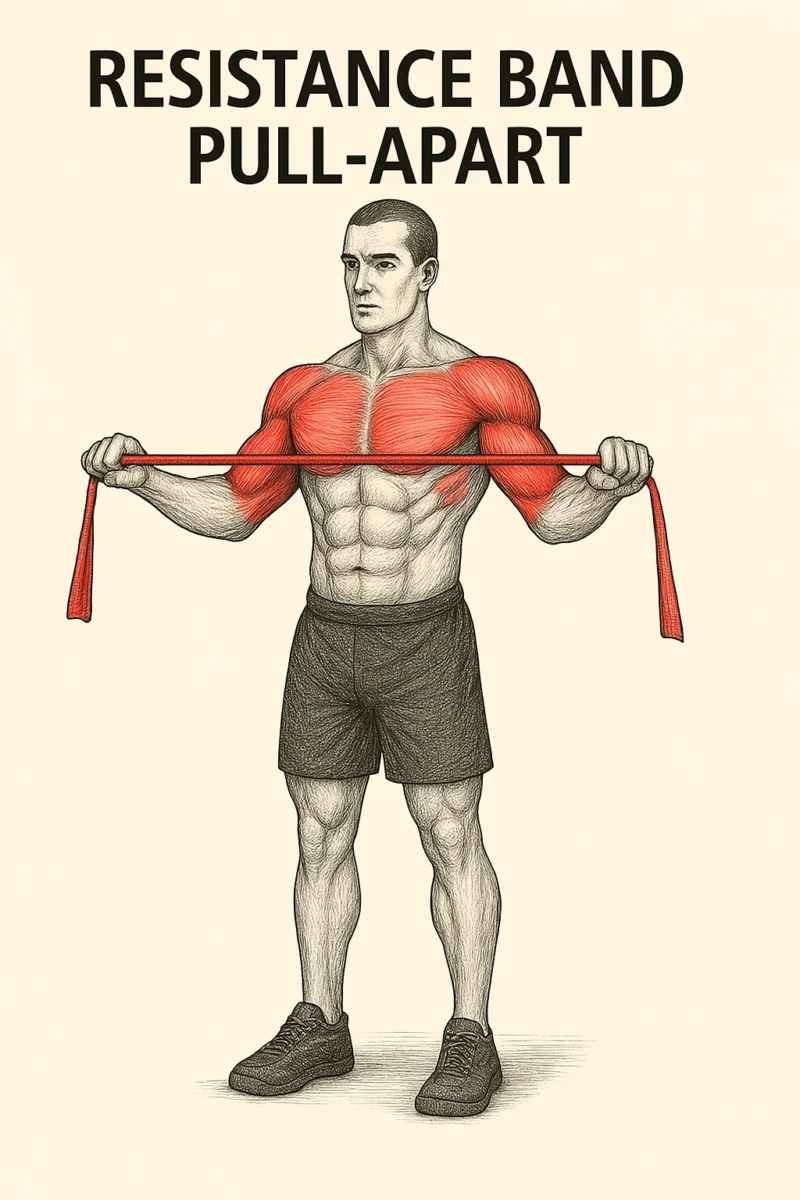
Directions:
- Stand with arms extended. Hold a resistance band taut in front of you with both hands so the band is parallel to the floor.
- Keeping your arms straight, pull the band to the chest by moving your arms out to the sides. Initiate the
Movement from your mid-back, squeeze your shoulder blades together, and keep your spine neutral. Slowly return to the starting position and repeat. - Perform 1–3 sets of 8–12 reps.
2. Lat Pulldown
When it comes to building an impressive back, the lat pulldown stands as one of the most effective exercises in your arsenal.
You’ll find this exercise particularly effective for targeting your latissimus dorsi, the large muscle group that gives your back its distinctive V-shape and helps prevent back pain when properly developed.
What makes the lat pulldown so valuable is its versatility. You can perform it using either a gym machine or resistance bands at home.
While primarily focusing on your lats, this compound movement also engages your rotator cuff, trapezius, posterior deltoids, rhomboids, and even your biceps and forearms.
To maximize muscular strength gains, focus on maintaining proper form and controlling the movement throughout each rep. Remember, it’s not just about pulling the weight down – it’s about building a foundation for overall back development.
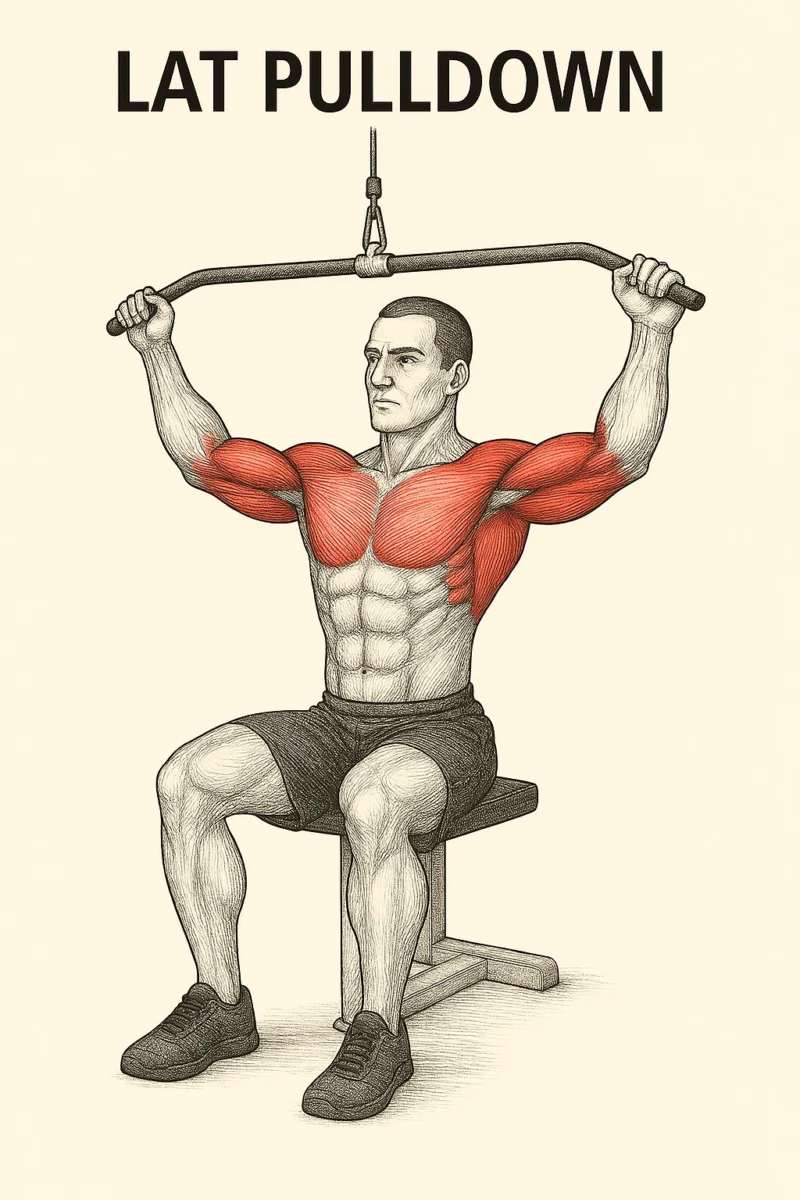
Directions:
- If you’re using a machine, position the pad so it’s touching your thighs. Stand up and grab the bar with hands wider than shoulder-width apart, then sit back down.
- Begin to pull the bar down toward your chest, bending your elbows and pointing them toward the floor. Engage your upper back and mid-back throughout the move. Keep your torso straight and avoid leaning back.
- Complete 1–3 sets of 8–12 reps.
3. Back Extension
Although many gym-goers focus primarily on mirror muscles, the back extension emerges as a fundamental exercise for developing strength in the posterior chain.
You’ll find this movement particularly effective for preventing muscle strains and building a resilient lumbar spine.
Back extensions primarily target your erector spinae muscles, which run along both sides of your spine.
While performing this exercise, you’ll also engage your hamstrings and glutes, creating a thorough workout for your entire posterior chain.
It’s particularly beneficial for beginners due to its straightforward nature and minimal equipment requirements.
Key benefits:
- Strengthens lower back muscles
- Improves posture and spinal stability
- Reduces the risk of back injuries
- Enhances overall athletic performance
- Complements deadlifts and squats effectively
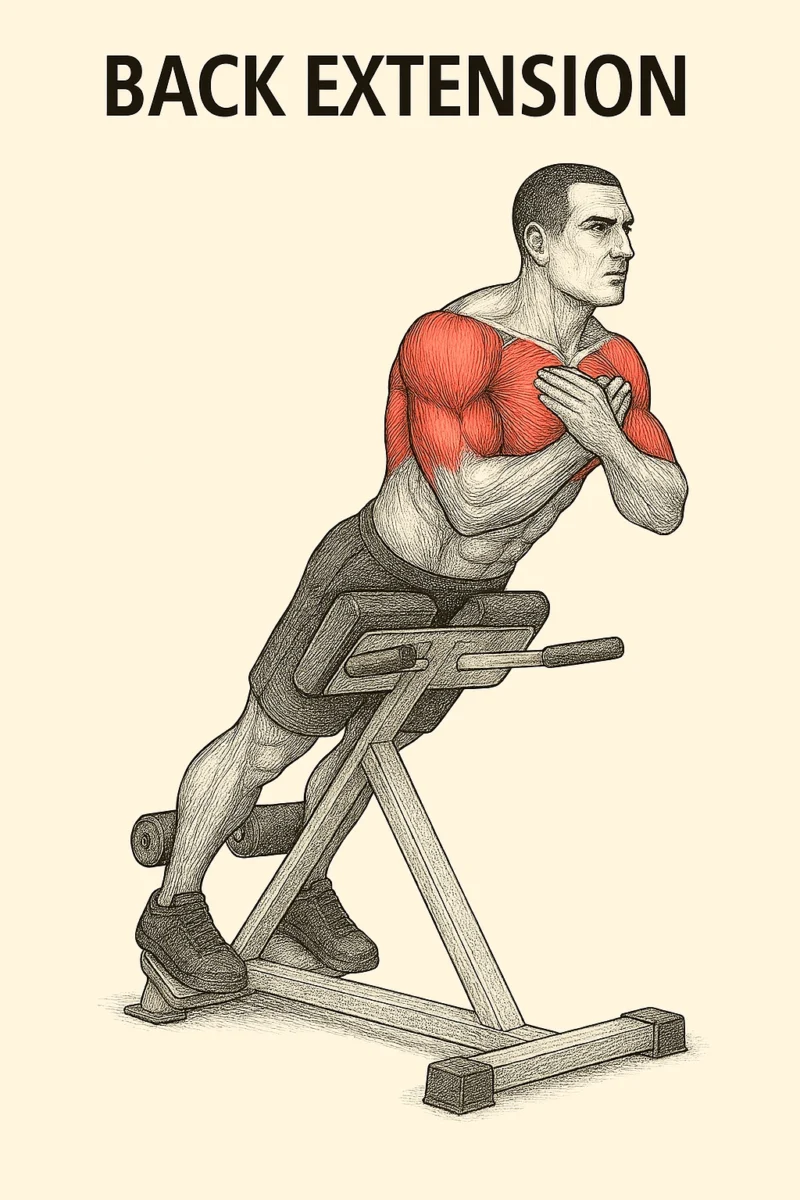
Directions:
- Lie facedown on an exercise ball with your abdomen on the center of the ball. Press the balls of your feet into the floor behind you to maintain your balance. You can position your feet against a wall for added support.
- Extend your arms overhead, in line with your ears. Bend first at your waist, bringing your body down toward the floor. This is your starting position.
- Slowly raise your upper body and arms toward the sky until your shoulders are above hip height. Engage your core and glutes, and keep your feet on the floor.
- Pause for a moment at the top, then slowly lower down.
- Complete 1–3 sets of 8–12 reps.
4. Suspended Row
Despite its simple setup, the suspended row stands as one of the most effective bodyweight exercises you’ll find for building a strong, defined back.
What makes the TRX row particularly valuable is its versatility – you can adjust the difficulty by simply changing your body position and angle.
This lat-focused training movement doesn’t just target your primary back muscles; it’s also one of the best core exercises you’ll encounter. As you pull yourself up, you’re engaging your latissimus dorsi, trapezius, and rhomboids while simultaneously strengthening your core stability.
The suspended row helps correct muscle imbalances by forcing both sides of your body to work independently and equally.
Whether you’re a beginner or an advanced athlete, you’ll benefit from incorporating this exercise into your routine.
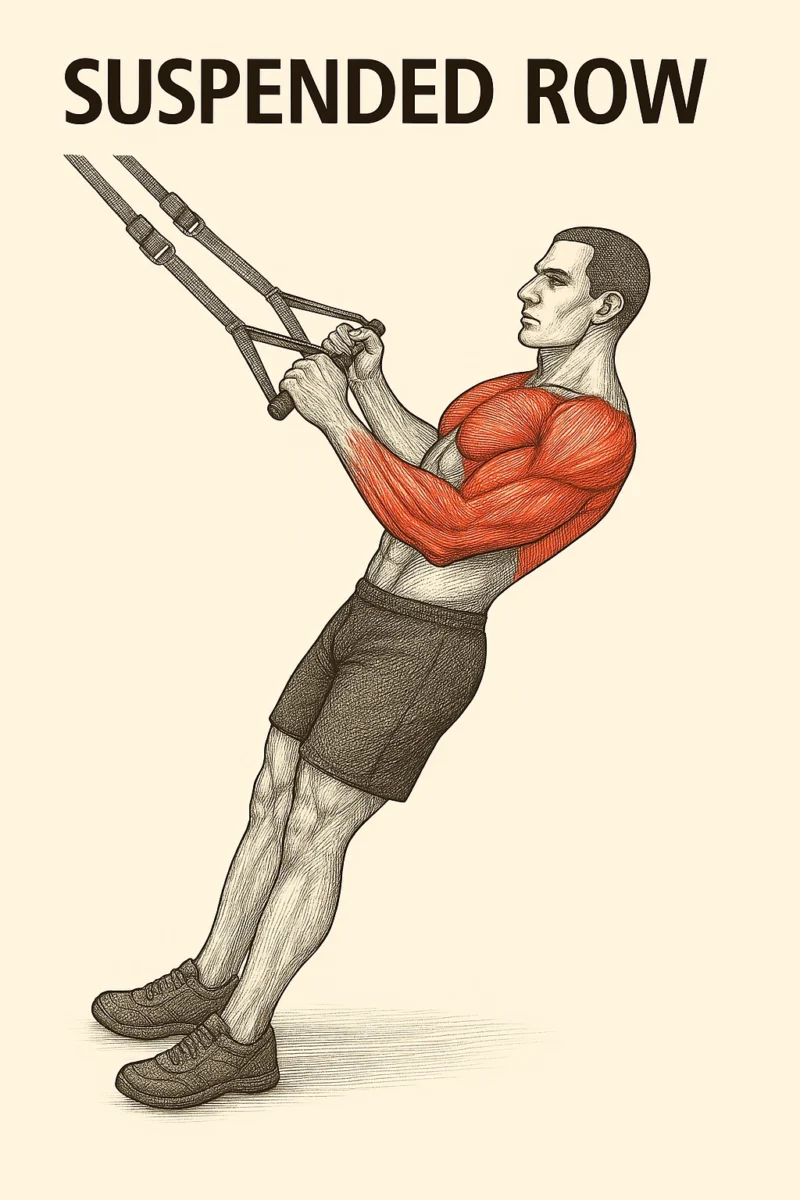
Directions:
- Grab TRX handles and walk under them, forming a tabletop position with arms extended. The more parallel your back is to the floor, the harder this exercise will be. You can also perform this move with straight legs, keeping your body in a single, straight line.
- Keeping your back straight and your elbows close to your sides, pull yourself up toward the ceiling.
- Extend your arms and return to the starting position.
- Complete 1–3 sets of 8–12 reps.
5. Quadruped Single-Arm Dumbbell Row
As you progress through your back training journey, the quadruped single-arm dumbbell row stands out as a fundamental exercise that’ll perfect your rowing technique.
By targeting each side independently, you’ll develop balanced strength while activating essential upper back muscles, including your lats, deltoids, and trapezius. This move is your gateway to mastering more complex rowing exercises.
It prevents common mistakes, such as overextending at the bottom or overcompensating with your lower back. You’ll notice improved muscle fiber recruitment in your latissimus dorsi, teres muscles, and rhomboids.
What makes this exercise particularly effective is its ability to correct muscular imbalances between your right and left sides. Consider it your foundation for building a stronger, more symmetrical back that’ll improve your overall lifting performance.
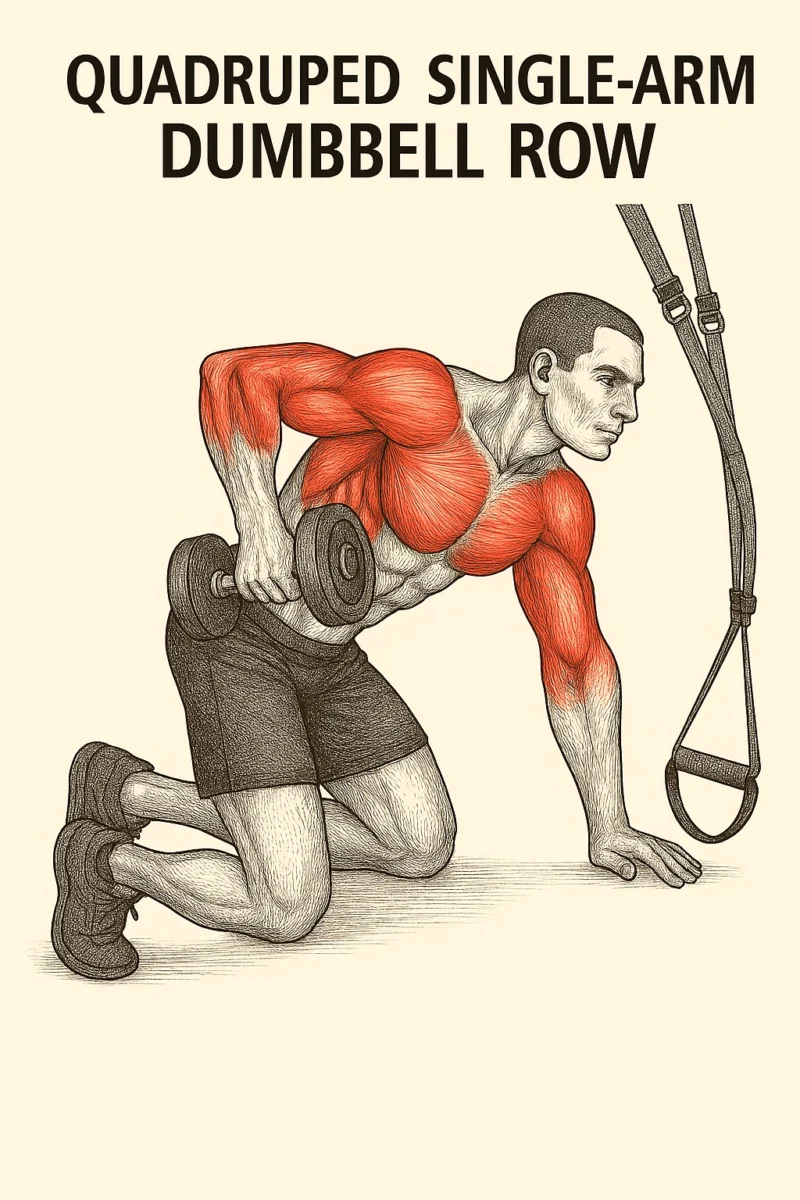
Directions:
- Start on hands and knees with a dumbbell positioned in each hand. Ensure your back is straight, your hands are directly below your shoulders, and your knees are below your hips.
- Row up and back with your right arm, bending your elbow and bringing the dumbbell to your armpit. Keep your elbow tucked at your side throughout the movement. You’ll notice that if you row too far, you’ll lose your balance.
- Slowly return the dumbbell to the starting position and repeat on the left side.
- Complete 1–3 sets of 8–12 reps on each side.
6. Wide Dumbbell Bent-Over Row
The powerhouse wide dumbbell bent-over row stands among the most effective mass-building exercises for your back. If you’re serious about training your back and want to muscle up like Arnold, this move delivers impressive results by targeting multiple muscle groups simultaneously.
Start with lighter weights, around 10 pounds, to master proper form before progressing to heavier weights. You’ll engage your latissimus dorsi, rhomboids, trapezius, and erector spinae through an enhanced range of motion that barbell rows can’t match. The dumbbell variation helps identify and correct strength imbalances between sides.
If you’re dealing with lower back issues, incorporate lower back stretches before attempting this exercise.
While it’s a powerful movement for building strength, always prioritize form over weight. The wide dumbbell bent-over row’s versatility makes it an essential addition to your back-building arsenal.
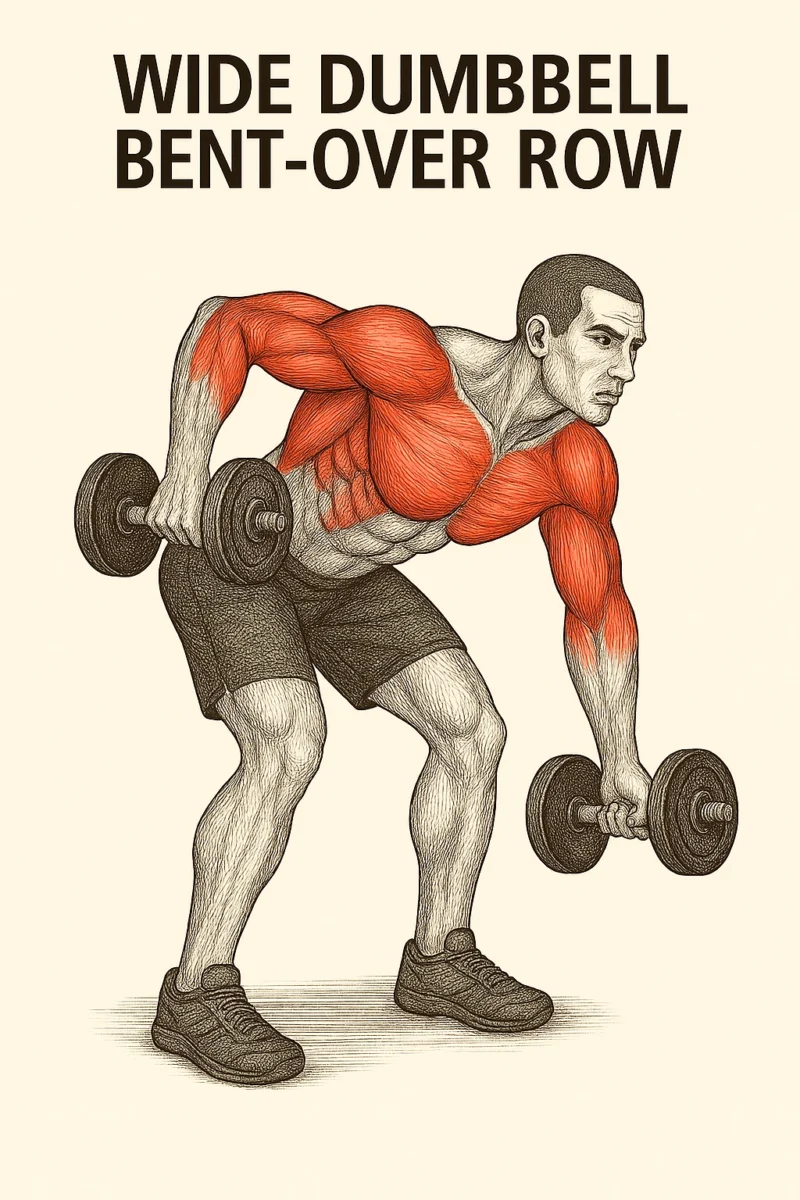
Directions:
- Hold a dumbbell in each hand with your palms facing your thighs, and stand with feet shoulder-width apart. Bend your knees slightly, keeping core engaged and neck neutral, and hinge at the hips until your torso forms a 45-degree angle with the floor. Allow the dumbbells to hang down in front of you.
- Begin to row with your elbows at a 90-degree angle, pulling them up toward the ceiling. Squeeze your shoulder blades together at the top of your back.
- Return to the starting position and repeat, completing 1–3 sets of 8–12 reps.
7. Barbell Deadlift
Mastering the barbell deadlift releases your body’s true strength potential like no other exercise. As one of the most effective compound lifts, it engages multiple muscle groups simultaneously while building raw power throughout your posterior chain.
You’ll notice immediate activation of your erector spinae muscles as you lift, while your shoulder stabilizers work overtime to maintain proper form. When you perform this movement correctly, it’s like orchestrating a symphony of muscle groups – from your upper back down to your calves, they all work together.
To maximize results, focus on engaging your entire posterior chain through the movement, keeping your back straight and chest up. Arnold himself considered the barbell deadlift essential for building that coveted V-taper and developing overall back thickness.
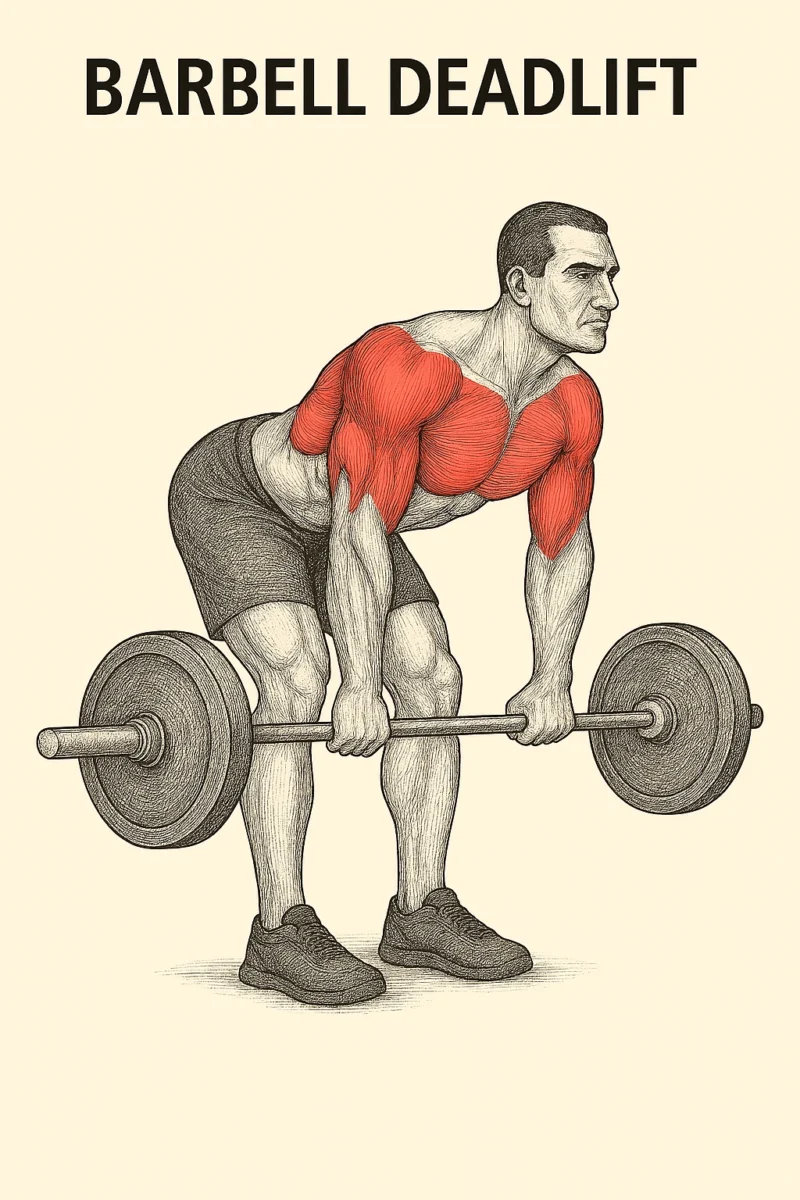
Directions:
- Stand behind a barbell with feet shoulder-width apart.
- Keeping your chest lifted, begin to hinge at your hips and slowly bend your knees, reaching down to pick up the barbell. Keep your back straight and grasp the bar with both palms facing you.
- Keeping feet flat on the floor, push back up to a standing position. Your back should remain straight throughout the movement, and your shoulders should be down and back.
- Return to the starting position, pushing your hips back and bending your knees until you bring the barbell back toward the floor.
- Complete 1–3 sets of 8–12 reps.
8. Single-Arm Dumbbell Row
Among the most effective unilateral back exercises, single-arm dumbbell rows build strength and size like few other movements can.
By stabilizing yourself on a bench, you can maximize your ability to target key muscles while maintaining proper form throughout each repetition.
The single-arm row primarily works your latissimus dorsi while engaging multiple supporting muscles, including your posterior deltoids and trapezius.
What makes this exercise particularly valuable is its ability to address muscular imbalances by working each side independently.
You’ll want to challenge yourself with progressive weight increases, but never at the expense of proper technique.
Keep your core tight and focus on squeezing your back muscles with each controlled pull.
The bench provides stability, allowing you to concentrate solely on the pulling motion and achieve peak muscle engagement.
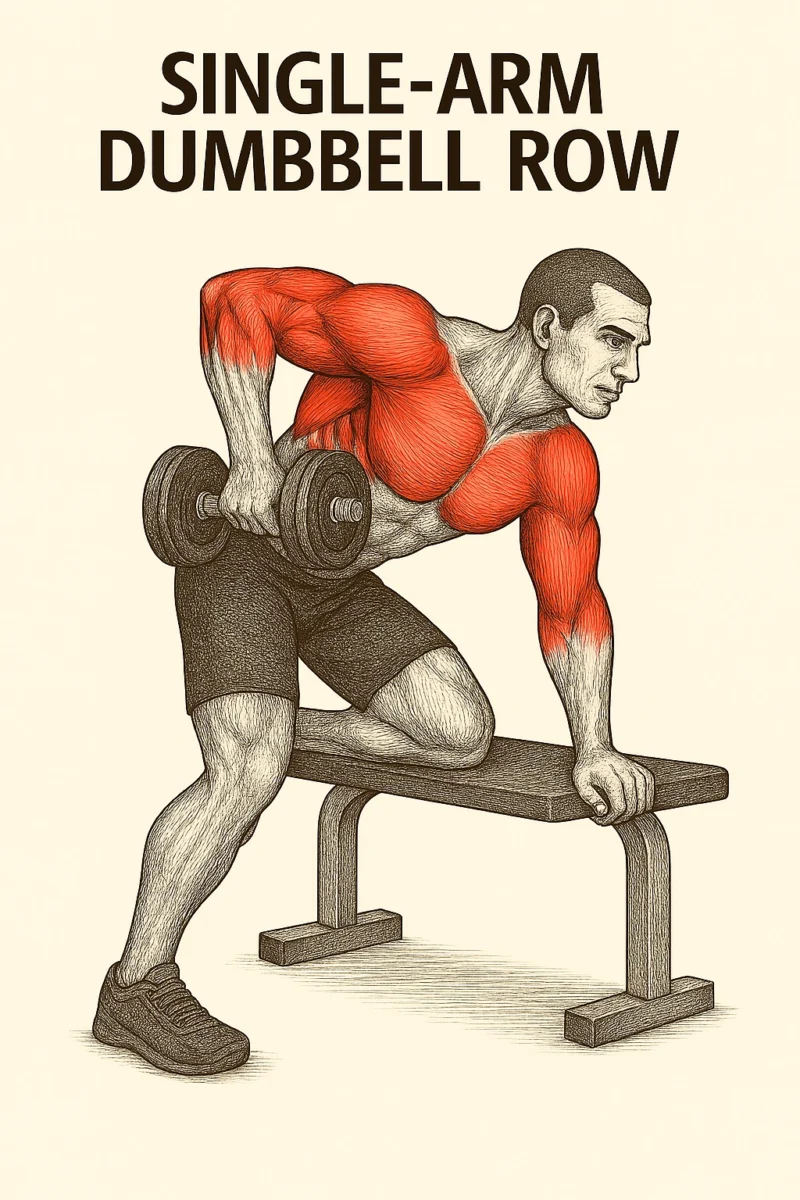
Directions:
- Position yourself on a bench so that your left knee and shin are resting on it, as well as your left hand — this will serve as your support. Your right leg should be straight with your foot on the floor. Pick up a dumbbell with your right hand. Maintain a straight torso.
- Pull the dumbbell up, aiming your elbow toward the sky while keeping it close to your body. Squeeze your upper back as you bend your elbow.
- Slowly lower back down to the starting position. Complete 1–3 sets of 8–12 reps on each side.
9. Renegade Row
The renegade row elevates your workout by combining a challenging plank position with dynamic dumbbell rows, creating one of the most effective full-body exercises you’ll encounter.
Unlike traditional exercises like the pull-up or weighted chin-up, this movement engages multiple muscle groups simultaneously.
While your latissimus dorsi and upper back muscles work similarly to a t-bar row, your core stays constantly activated to maintain stability. You’ll find this bodyweight exercise with added resistance particularly effective at developing functional strength.
To incorporate this into your exercise regimen:
- Start in a plank position, holding dumbbells
- Keep your core tight and hips stable
- Row one dumbbell up while maintaining balance
- Alternate arms with controlled movements
- Perform 3 sets of 8-12 reps per side
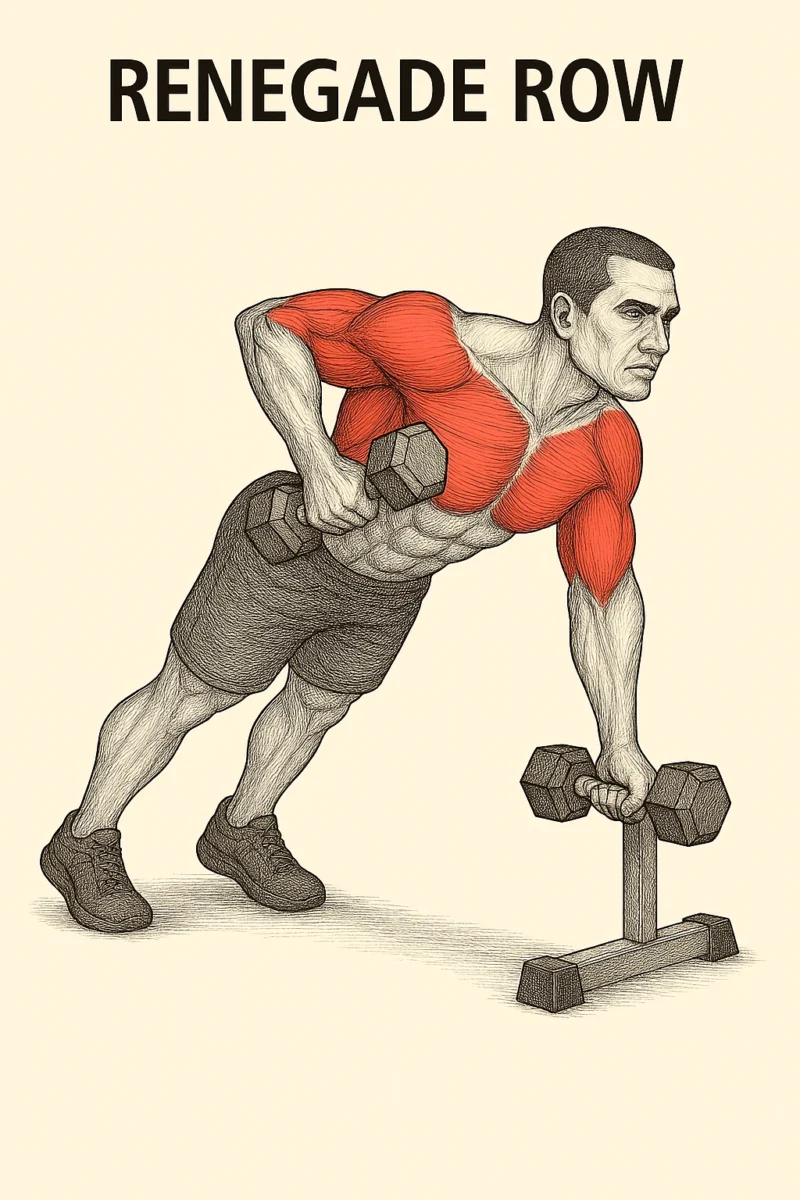
Directions:
- Assume a high plank position with each of your hands on a dumbbell. Your body should form a straight line from your head to your toes, and your core should be engaged throughout the movement.
- Row with your right arm, pulling your elbow toward the sky while keeping it close to your body, then return the dumbbell to the floor. Keep your hips square to the floor.
- Repeat with your left arm. Alternatively, completing 20 total reps for 1–3 sets.
10. Reverse Fly
Building strength in your posterior chain becomes effortless with reverse flys, an essential movement that targets often-neglected muscles responsible for good posture and shoulder stability.
When performing the reverse fly, you’ll engage three key muscle groups: your rhomboids, trapezius, and posterior deltoids. These postural muscles work together to maintain proper spine alignment and shoulder positioning throughout your daily activities.
Start with lightweight dumbbells, ideally 5 pounds, and focus on maintaining proper form before increasing the weight. If you’re experiencing lower back issues, approach this exercise with caution and consider consulting a fitness professional before attempting it.
As your strength improves, you’ll notice better posture, reduced tension in your upper back, and increased stability in your shoulder region.
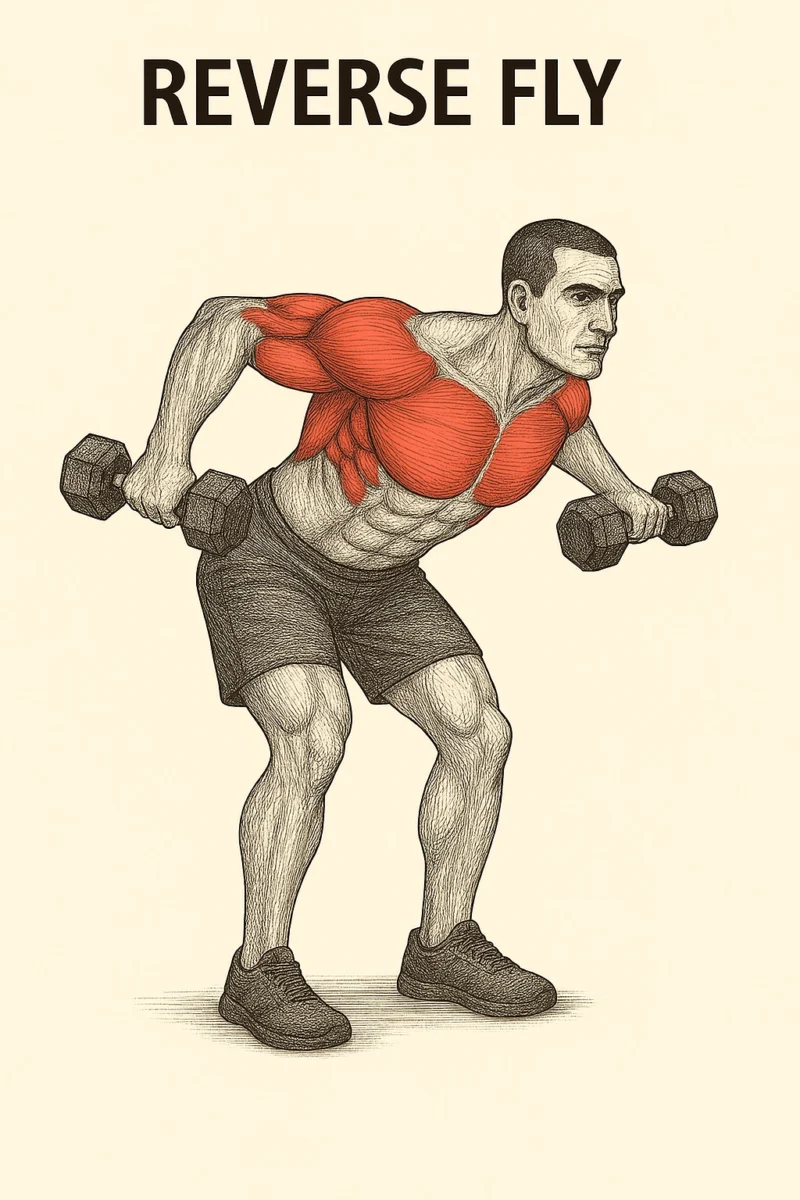
Directions:
- Holding a dumbbell in each hand, hinge forward at your hips until your torso forms a 45-degree angle with the floor, allowing the dumbbells to hang in front of you with your palms facing each other. Have a slight bend in your elbows.
- Engaging your core, lift your arms up and out, squeezing your shoulder blades at the top.
- Slowly return to the starting position. Complete 1–3 sets of 8–12 reps.
11. Pull up
Mastering pull-ups remains one of the most impressive demonstrations of upper-body strength, which is why Arnold Schwarzenegger incorporated them regularly into his back-building routine.
When you grab that pull-up bar, you’re engaging multiple muscle groups simultaneously, particularly your latissimus dorsi and trapezius.
While pull-ups can be challenging for beginners, don’t let that discourage you. If you’re not ready for unassisted pull-ups, start with an assisted pull-up machine or resistance bands to gradually build your strength. These variations will help you develop the necessary muscles while maintaining proper form and technique.
Your back muscles aren’t working alone – your chest, shoulders, forearms, and core all pitch in during this compound movement.
That’s precisely why the pull-up is considered a fundamental exercise for building impressive upper-body strength.

Directions:
- Grab a pullup bar with an overhand grip, placing your hands wider than shoulder-width apart.
- Lift your feet off the floor — or place them in the assist band — and hang from your arms.
- Pull your body up to the bar by bending your arms and pulling your shoulder blades toward the floor.
- Once your chin crosses the bar, lower your body back down.
- Complete 1–3 sets of 8–12 reps.
12. Smith machine row
While traditional barbell rows require significant stabilization, Smith machine rows offer a more controlled alternative, allowing you to focus purely on engaging your back muscles.
You’ll appreciate how the fixed path of the Smith machine helps maintain proper form throughout the movement.
This exercise primarily targets your latissimus dorsi, but don’t underestimate its impact on your trapezius and posterior deltoids.
The guided motion helps you concentrate on squeezing these upper back muscles without worrying about balance. When you’re aiming to build a back that rivals Arnold’s famous Christmas tree shape, Smith machine rows should be in your arsenal.
To maximize results:
- Keep your core tight
- Pull with your back, not your arms
- Focus on controlled movements
- Maintain a neutral spine throughout
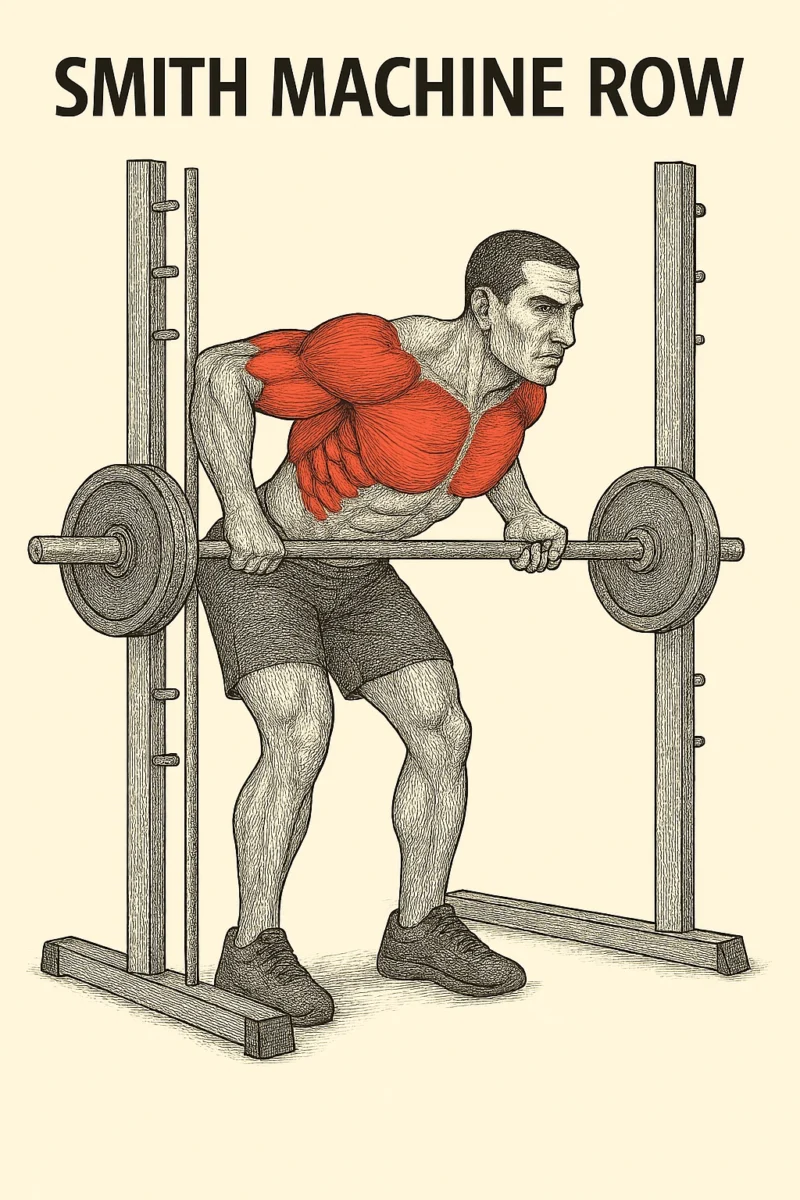
Directions:
- Stand behind the Smith machine bar with your feet shoulder-width apart.
- Hinge at your hips, slightly bend your knees, and maintain a neutral spine.
- Place your hands over the bar with an overhand grip, a little wider than shoulder-width apart.
- Pull the bar up toward your chest by squeezing your shoulder blades together. Avoid using your arms to do most of the work.
- Slowly return the bar to the starting position.
- Perform 1–3 sets of 8–12 reps.
13. Seated row
Grab a seat at the cable machine and prepare to sculpt your back with one of Arnold’s favorite mass-building exercises.
The seated cable row isn’t just a basic pulling movement; it’s a thorough back builder that keeps your muscles engaged throughout the entire range of motion.
You’ll feel your latissimus dorsi and rhomboids working overtime as you pull the weight, while your trapezius and biceps join the party as secondary movers.
What makes this exercise particularly effective is the constant tension provided by the cable system – there’s no “resting” point like you might find with free weights.
When performed correctly, seated rows help develop that coveted V-taper physique the Austrian Oak was famous for.
Plus, the controlled movement pattern helps minimize the risk of injury while maximizing muscle growth.
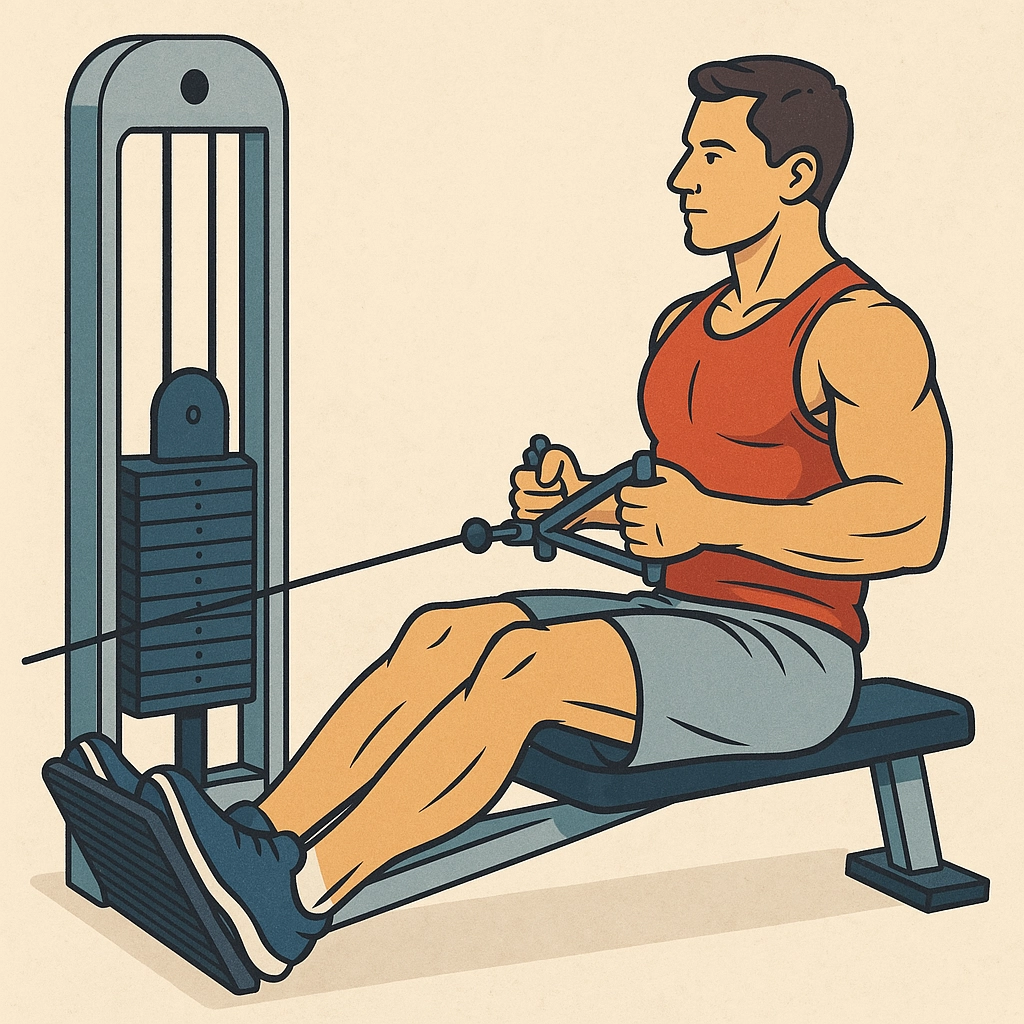
Directions:
- Adjust the cable row seat so that the handles are at chest height.
- Sit up straight and place your feet flat on the floor or on the foot supports.
- Grab the handles and hold them in front of you with your arms extended.
- Pull the handles toward your chest by squeezing your shoulder blades and drawing your elbows back. Keep your elbows close to your body.
- Return to the starting position with slow, controlled movement.
- Perform 1–3 sets of 8–12 reps.
14. Chest-supported row
The chest-supported row takes stability to the next level. By leaning your chest against a bench, you’ll eliminate any cheating or swinging motions that often creep into traditional rows. This push-and-pull workout staple lets you focus purely on engaging your latissimus dorsi.
For ideal men’s health and exercise & fitness results, the chest-supported row offers unique advantages. You can typically handle heavier weights since the bench provides additional support, allowing for greater muscle activation. Arnold himself was known to incorporate this variation into his back routines, noting how it helped him maintain strict form while building his legendary V-taper.
To maximize benefits, keep your chest firmly pressed against the bench throughout the movement. Pull the weight straight back, squeezing your lats at the top of each rep.
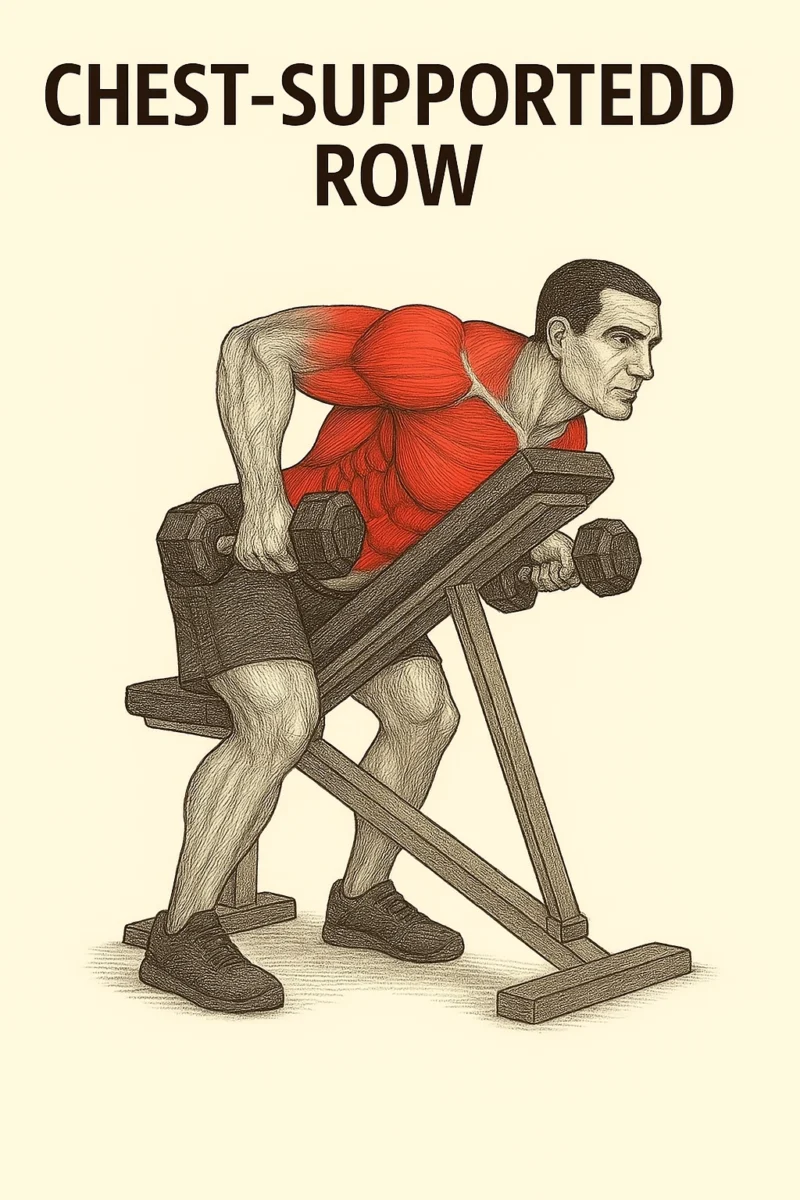
Directions:
- Position an adjustable exercise bench so that the backrest is at a 45-degree angle.
- Grab a pair of dumbbells and sit on the bench with your chest facing the backrest.
- Plant your feet on the floor, engage your core, and slowly lean forward until your chest is against the backrest.
- Holding a dumbbell in each hand, extend your elbows and let your arms hang straight down. This is the starting position.
- At the same time, squeeze your shoulder blades and bend your elbows to bring the dumbbells toward your rib cage.
- Slowly reverse the movement to return to the starting position.
- Perform 1–3 sets of 8–12 reps.
15. Dumbbell pullover
One uniquely challenging movement that builds both chest and back strength is the dumbbell pullover, a classic exercise championed by bodybuilding legends.
Unlike the barbell bent-over row or cable row, this movement targets both your chest and latissimus dorsi simultaneously while improving shoulder mobility.
When you’re ready to progress beyond basic moves like scapula shrugs or Romanian deadlift, the dumbbell pullover offers an advanced challenge.
However, it’s essential to start with lighter weights to master proper form.
You’ll engage your core throughout the movement to maintain a neutral spine and prevent arching when the weight moves overhead.
This thorough exercise not only strengthens multiple muscle groups but also enhances your overall upper body functionality, making it a valuable addition to your back-training arsenal.
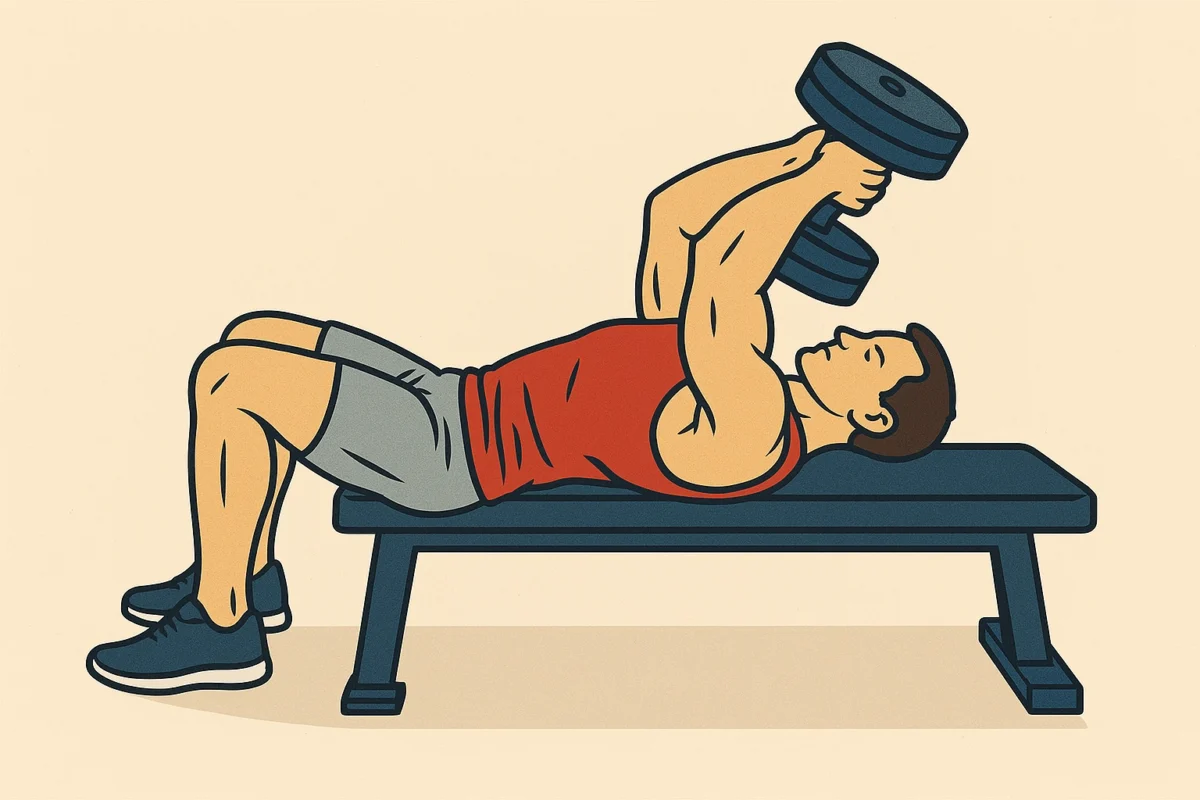
Directions:
- Select two lightweight dumbbells (it’s best to start with lighter weights to ensure correct form and maximize range of motion).
- Lie face up on an exercise bench with your feet flat on the floor and a dumbbell in each hand resting against your chest.
- Engage your core and extend your arms upward toward the ceiling, keeping them in front of your chest. Keep the dumbbells close to one another, elbows slightly bent, and palms facing inward. This is the starting position.
- Slowly extend your arms back to bring the dumbbells back and over your head. Avoid going farther than your ears, keeping your arms visible out of the corner of your eye. Ensure your ribs remain in contact with the bench.
- Pause, and then slowly bring the dumbbells back to the starting position.
- Perform 1–3 sets of 8–12 reps.
Does Strengthening Back Muscles Improve Posture?
Strengthening back muscles improves posture by supporting the spine and maintaining proper alignment. Strong back muscles work with core muscles to provide spinal stability.
Perform targeted back exercises to enhance posture, reduce slouching, and improve balance in daily activities.
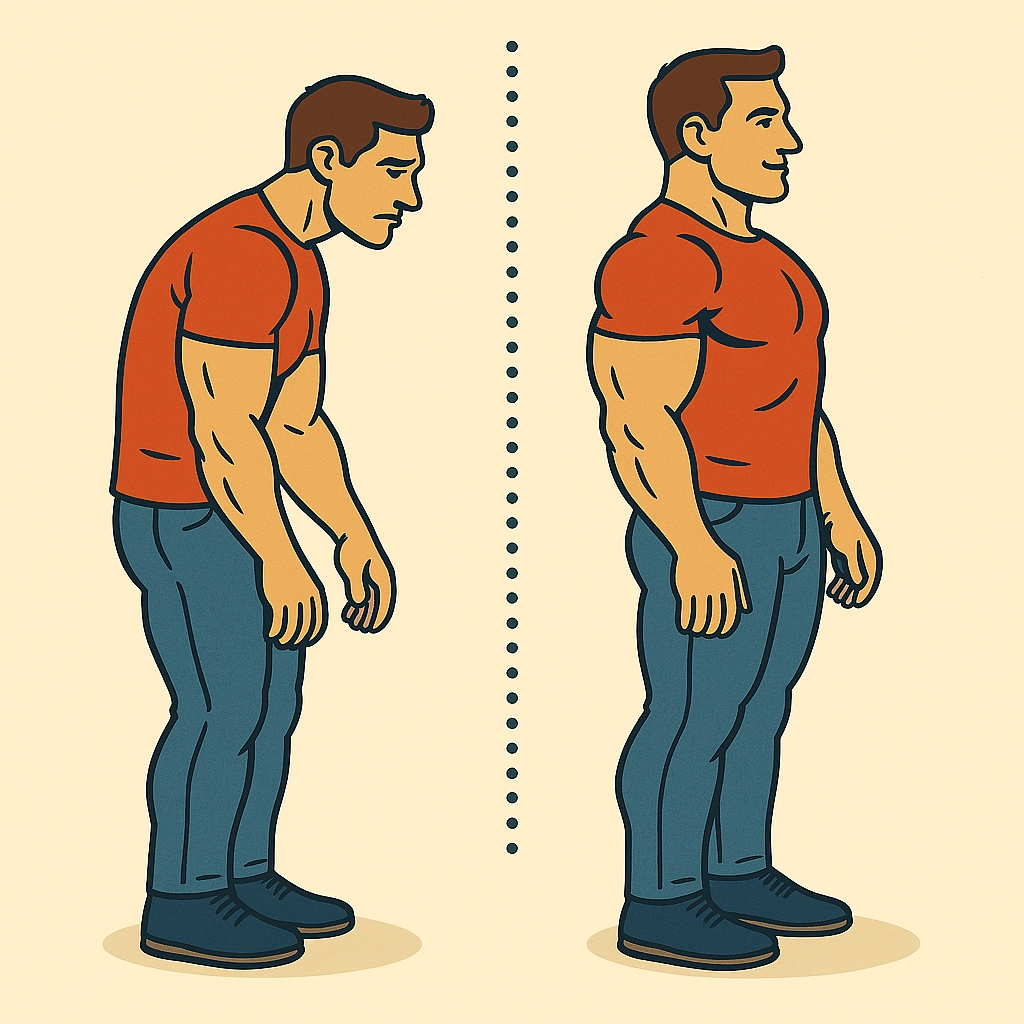
Here’s what happens when you strengthen your back:
- Better shoulder blade positioning
- Reduced forward head posture
- Decreased risk of lower back pain
- Enhanced spinal alignment
- Improved daily movement patterns
- Greater core stability during activities
Remember: better posture isn’t just about looking confident—it’s about creating a foundation for long-term spinal health.
To Wrap It All Up
You’ve got all the tools to build a stronger, healthier back. By incorporating these exercises into your routine, you’ll notice improved posture, reduced discomfort, and enhanced athletic performance.
Remember Arnold’s famous words: “The last three or four reps are what make the muscle grow.” Stay consistent with proper form, and you’ll transform your back from a weak link into your body’s powerhouse. Now get out there and crush your goals!
FAQs
What Are the Best Back Workouts for Beginners?
The best back workouts for beginners include bodyweight rows, reverse snow angels, supermans, and resistance band pull-aparts. Perform these exercises with proper form for 2-3 sets of 10-15 reps to build foundational back strength and improve posture without risking injury.
Can I Do Back Workouts at Home Without Equipment?
You can do back workouts at home without equipment by performing supermans, reverse snow angels, Y-T-I raises, and prone back extensions. These exercises strengthen your upper and lower back effectively using only bodyweight resistance.
Best Back Workout Routine for Mass
Build back mass with deadlifts, barbell rows, pull-ups, lat pulldowns, and seated cable rows. Perform 4-5 sets of 6-10 reps each, focusing on progressive overload to stimulate muscle growth effectively.
Back Workout With Dumbbells vs Barbells
The main difference between back workouts with dumbbells and barbells is stability and muscle activation. Dumbbells allow unilateral training and greater range of motion, while barbells enable heavier lifts and maximal compound loading for mass.
How to Combine Back Workouts With Deadlifts
Combine back workouts with deadlifts by placing deadlifts at the start of your back day routine as a primary strength movement, followed by rows, pull-ups, and accessory isolation exercises to target all back muscles comprehensively.
Best Resistance Bands for Back Workouts to Buy
The best resistance bands for back workouts include Fit Simplify Loop Bands, Serious Steel Heavy Duty Bands, and Whatafit Resistance Bands Set. Choose bands with varying resistance levels to perform rows, pull-aparts, and lat-focused exercises effectively.
Buy Back Workout Program Online
Buy a back workout program online by choosing reputable platforms like Bodybuilding.com, Athlean-X, or Jeff Nippard programs. These offer structured plans with progressive overload, exercise tutorials, and coaching support for effective back development.

